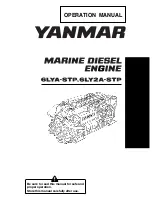
Section 4 - Maintenance
90-8M0113987
eng
DECEMBER 2015
Page 67
5. Place the remote control in neutral, idle speed position and start the engine.
NOTICE
Operating the engine out of the water at high speeds creates suction, which can collapse the water supply hose and overheat
the engine. Do not operate the engine above 1400 RPM out of the water and without sufficient cooling water supply.
6. Operate the engine at idle speed in neutral for about ten minutes or until the discharge water is clear.
7. Observe the water temperature gauge to ensure that the engine is operating in the normal range.
8. Stop the engine.
9. Shut off the water tap.
10. Remove the adapter from the seawater pump inlet hose connection.
11. Do not open the seacock or reconnect the water inlet hose at this time to prevent water from siphoning into the boat or
engine.
12. Place an appropriate tag on the key switch stating that the seacock must be opened or the seawater inlet hose must be
reconnected before operating the engine.
Engine Seawater Pump Inspection
IMPORTANT: Mercury strongly recommends that this service be performed by a Mercury Diesel authorized repair facility.
Remove and inspect the engine seawater pump at the interval specified in the
Maintenance Schedule
. See your Mercury
Diesel authorized repair facility.
Replacing the Engine Coolant in the Closed‑Cooling System
Draining the Closed‑Cooling System
NOTICE
Discharge of oil, coolant, or other engine/drive fluids into the environment is restricted by law. Use caution not to spill oil,
coolant, or other fluids into the environment when using or servicing your boat. Be aware of the local restrictions governing
the disposal or recycling of waste, and contain and dispose of fluids as required.
NOTE: For instructions on draining the seawater section, refer to
Draining the Seawater System
in this section.
IMPORTANT: Observe the following points.
•
Ensure that the engine is as level as possible to promote complete draining of the cooling system.
•
The closed‑cooling section must be filled year‑round with the required coolant. If the engine will be exposed to freezing
temperatures, ensure that the closed‑cooling section is filled with a solution of ethylene glycol antifreeze and water properly
mixed to protect the engine to the lowest temperature to which it will be exposed.
•
Do not use propylene glycol antifreeze in the closed‑cooling section of the engine.
!
CAUTION
A sudden loss of pressure can cause hot coolant to boil and discharge violently resulting in serious injury from burns. Allow
the engine to cool down before removing the coolant pressure cap.
1. Allow the engine to cool.
2. Remove the pressure cap from the expansion tank and coolant reservoir.
NOTE: Drain coolant into a suitable container. Dispose of old coolant properly.
3. Remove the intake and exhaust manifold drain plug.
Содержание 2.8 Diesel
Страница 2: ......
Страница 8: ...Page iv 90 8M0113987 eng DECEMBER 2015...
Страница 24: ...Section 1 Getting to Know Your Power Package Notes Page 16 90 8M0113987 eng DECEMBER 2015...
Страница 38: ...Section 2 On the Water Notes Page 30 90 8M0113987 eng DECEMBER 2015...
Страница 44: ...Section 3 Specifications Notes Page 36 90 8M0113987 eng DECEMBER 2015...
Страница 104: ...Section 4 Maintenance Notes Page 96 90 8M0113987 eng DECEMBER 2015...
Страница 110: ...Section 5 Storage Notes Page 102 90 8M0113987 eng DECEMBER 2015...
Страница 122: ......
















































